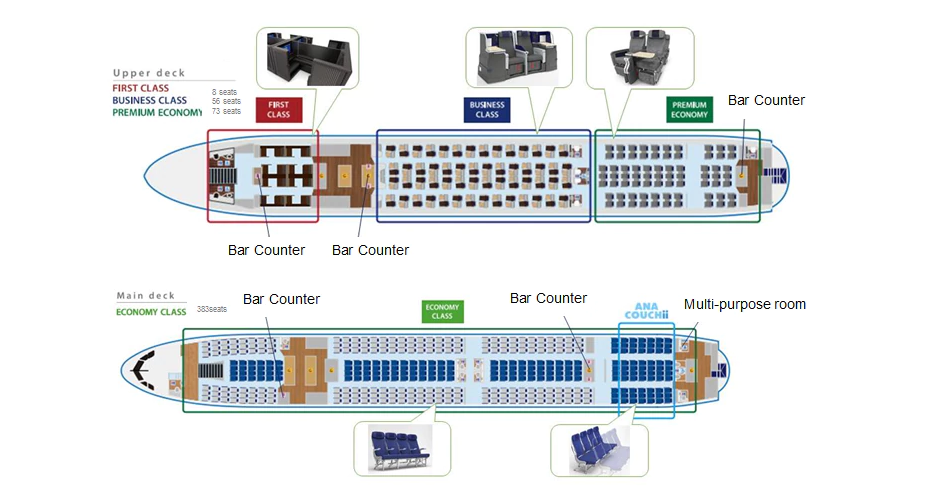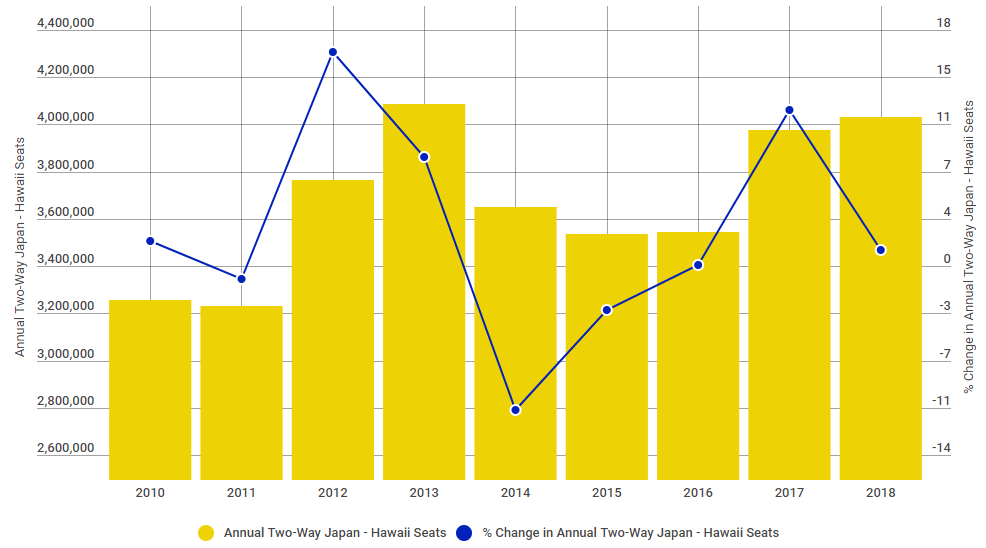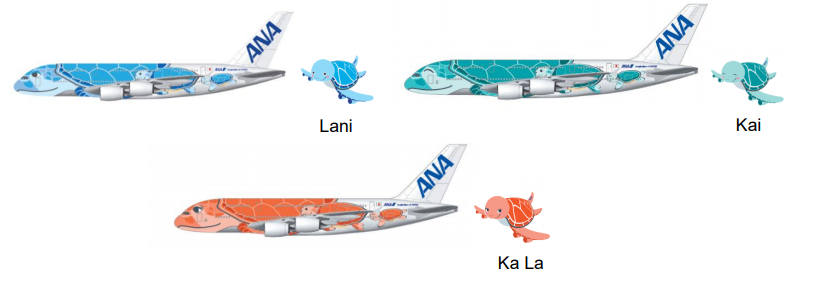Summary:
- All Nippon Airways (ANA) confirms its A380 fleet will be configured in a 520-seat arrangement comprising eight first class, 56 business, 73 premium economy and 383 economy seats;
- This will be the second most densely arranged A380 configuration, behind the 617-seat two-class version of the aircraft flown by Emirates Airline;
- ANA has agreed to acquire three A380s from Airbus and will introduce them into service on the Tokyo - Honolulu market from spring 2019. Each aircraft will be painted in a special 'Flying Honu' livery in shades of blue, green and orange.
- Flights between Japan and Hawaii represent a highly competitive market - around 1.5 million Japanese travel to Hawaii annually, with airlines enjoying consistently high load factors.
ANA will offer a four class flying experience on the A380 with a premium upper deck arrangement of 137 seats including eight in first class, 56 in business, and 73 in premium economy. The lower deck will provide economy seating for 383 passengers. This will be the first time that the carrier has offered a first class product on the Tokyo - Honolulu route, which is particularly popular with the leisure market.
The business class cabin will be arranged in a 1-2-1 configuration with the centre of the cabin seats offering seats together as a pair or either side of a table divider. ANA acknowledges that the adjacent seats would prove particularly popular with couples, including newlyweds, that frequent the Honolulu route.
"Honolulu is loved by many Japanese families, couples, newlyweds, and Hawaii is a popular destination for their vacations and honeymoons. With this in mind, ANA aims to make their experience onboard more comfortable by strategically designing the cabin features in order to meet their unique needs while providing them with a once in a lifetime experience," says the airline.
 The Economy cabin will be arranged with a 34in pitch but will also incorporate a number of rows at the rear of the lower deck and through the centre of the cabin that will have a 32in pitch, but can be adapted into a couch seat design. ANA says the ANA Couchii seats will be positioned at a higher price point that the standard Economy seats.
The Economy cabin will be arranged with a 34in pitch but will also incorporate a number of rows at the rear of the lower deck and through the centre of the cabin that will have a 32in pitch, but can be adapted into a couch seat design. ANA says the ANA Couchii seats will be positioned at a higher price point that the standard Economy seats.
"Each couch is comprised of three or four seats and passengers are able to lie on the seats by folding up the leg rests," explains the airline. "In addition, passengers will receive a dedicated mattress that will provide them with further comfort." ANA says it is the first airline in Japan to introduce this concept onboard its aircraft.
The A380 will debut in commercial operation from spring 2019 and Airbus confirmed that the main sections of the first aircraft for ANA arrived at its Airbus final assembly line in Toulouse, France in mid Mar-2018. ANA's parent company ANA Holdings placed a firm order for three A380s in the second half of Jan-2016 and will be the first Japanese airline to operate the type.
Each of the three aircraft painted in a special 'Flying Honu' Hawaiian green sea turtle livery, symbolising good luck and prosperity. ANA selected the design from among 2,197 submissions from around the world, which were received by the airline during an open design contest conducted in the final quarter of 2016. Known as 'Honu' in the Hawaiian language, the green sea turtle is considered a sacred creature.
Alongside a blue design revealed last year, ANA now confirms the additional two aircraft will be painted in an emerald green scheme, inspired by the crystal clear waters of the Hawaiian ocean, and an orange design in reference to the Hawaiian sunset. The airline has even given each aircraft its own character - the blue character is Lani, meaning sky; the green character is Kai, meaning ocean; and the orange character is Ka La, meaning sunset.
Flights between Japan and Hawaii represent a highly competitive market - around 1.5 million Japanese travel to Hawaii annually, with airlines enjoying consistently high load factors. This market grew +5.4% in 2017 with Japanese visitors spending an estimated USD2.22 billion.
Hawaii is a major leisure market for Japanese tourists and ANA currently offers three flights a day to Honolulu from the Japanese capital - two from Narita International Airport and one from Haneda International Airport. Since Sep-2017 these flights have been exclusively flown using Boeing 787-9 equipment.
A closer look at it's the airline flight schedules shows that the Tokyo - Honolulu city pair market can be served on a daily basis with just a single aircraft with a seven hour block time from Japan and nine-and-half hour return flight from Hawaii. This would certainly have influenced ANA's configuration decision as it will certainly be considering other markets for the aircraft to maximise utilisation.
CHART - Air capacity between Japan and Hawaii returned to growth in a big way in 2017 buoyed by the new AirAsia X and Scoot low-cost links between Osaka and Honolulu; a more modest rise of +1.4% is forecast for 2018, based on published flight schedules Source: The Blue Swan Daily and OAG
Source: The Blue Swan Daily and OAG
The Blue Swan Daily analysis of OAG schedule data shows that total non-stop capacity between Japan and Hawaii grew a significant +12.1% last year, the second largest annual rise this decade and followed year-over-year declines in 2014 and 2015 and an only modest growth of +0.3% in 2016. This year, published schedules show capacity up +1.4% versus 2017, but a growth that will bring annual two-way seats back above four million for the first time since 2013.
There are currently eight airlines offering scheduled flights between Japan and Hawaii, with AirAsia X and Scoot both introducing long-haul low-cost operations between Osaka and Honolulu from Jun-2017 and Dec-2017 as an extension of its flights from their Kuala Lumpur and Singapore bases. All of these flights operate into Honolulu International Airport in the capital and largest city of the US state on the island of Oahu with the exception of a Hawaiian Airlines and Japan Airlines links between Tokyo (Haneda for Hawaiian and Narita for JAL) and Ellison Onizuka Kona International Airport Hawaii's Western island.
